23.5Busway Colorization and Delineators
Just as one can compose colors, or forms, so can one compose motions.William Calder, sculptor, 1898-1976
Overview
Enforcing the exclusive right-of-way of the busway is critical to achieving high vehicle speeds, but the means by which it is enforced are multiple and somewhat context specific. The infringement of the busway by private vehicles can do much to harm BRT speeds and overall performance (Figures 23.13 and 23.14). Even just a few vehicles can cause delays to the BRT vehicles. Further, once a few vehicles enter the system, then a breakdown in the appearance of enforcement can lead to mass violations of the exclusive space. The BRT Standard deducts points if there is any lack of enforcement of the exclusive right-of-way.
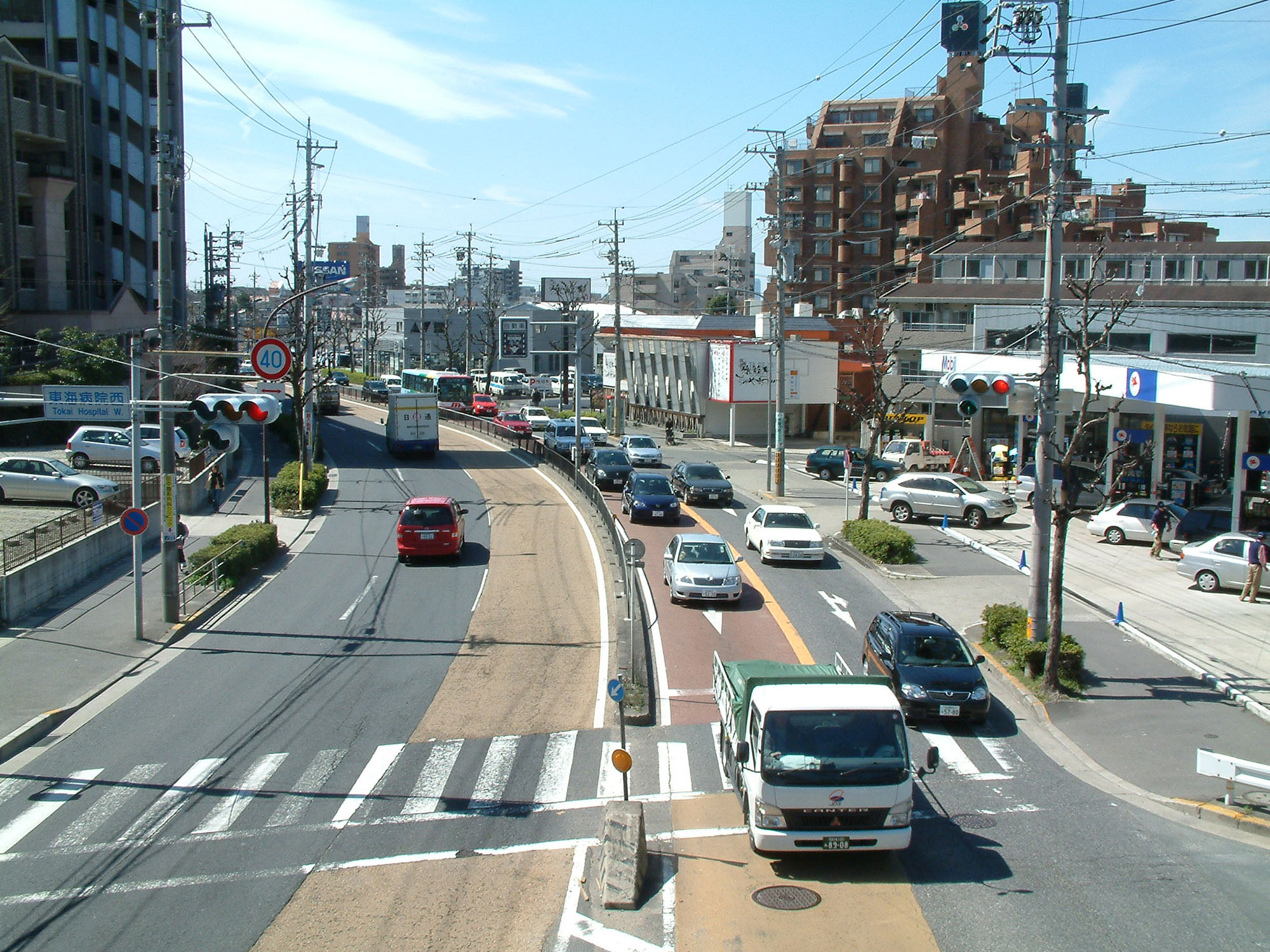
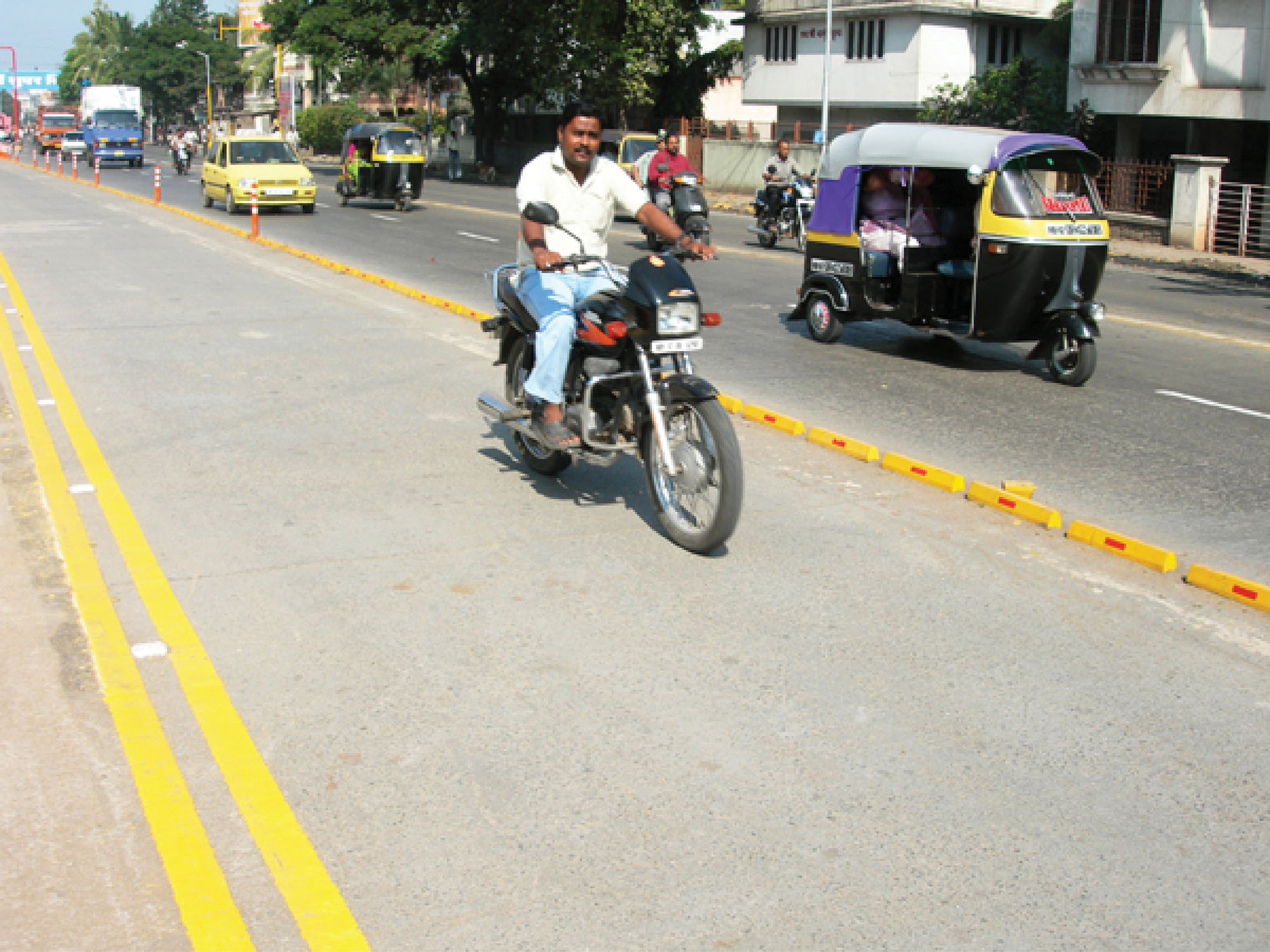
Enforcement that is self-enforcing is of great benefit to a BRT system, as it removes the burden of ongoing traffic enforcement, which has an associated additional operational cost. Delineation of busways together with colorization, will provide the greatest opportunity for self-enforcement, and the capital cost of these interventions will need to be weighed against ongoing traffic-enforcement costs along the entire corridor and ultimately the entire BRT network.
23.5.1Busway Colorization
The aesthetic appearance of the lanes will have an impact on the public’s image of the system. A smartly colored busway not only raises the image of the system but also creates a greater sense of permanence to the existence of the system. Colored lanes also create a psychological advantage over motorists, who may potentially block the busway when the lane must cross mixed traffic. Motorists are more likely to recognize that they are committing a traffic infraction by blocking a highly visible busway, especially when compared to the crossing of a lane that is indistinguishable from a normal mixed traffic lane.
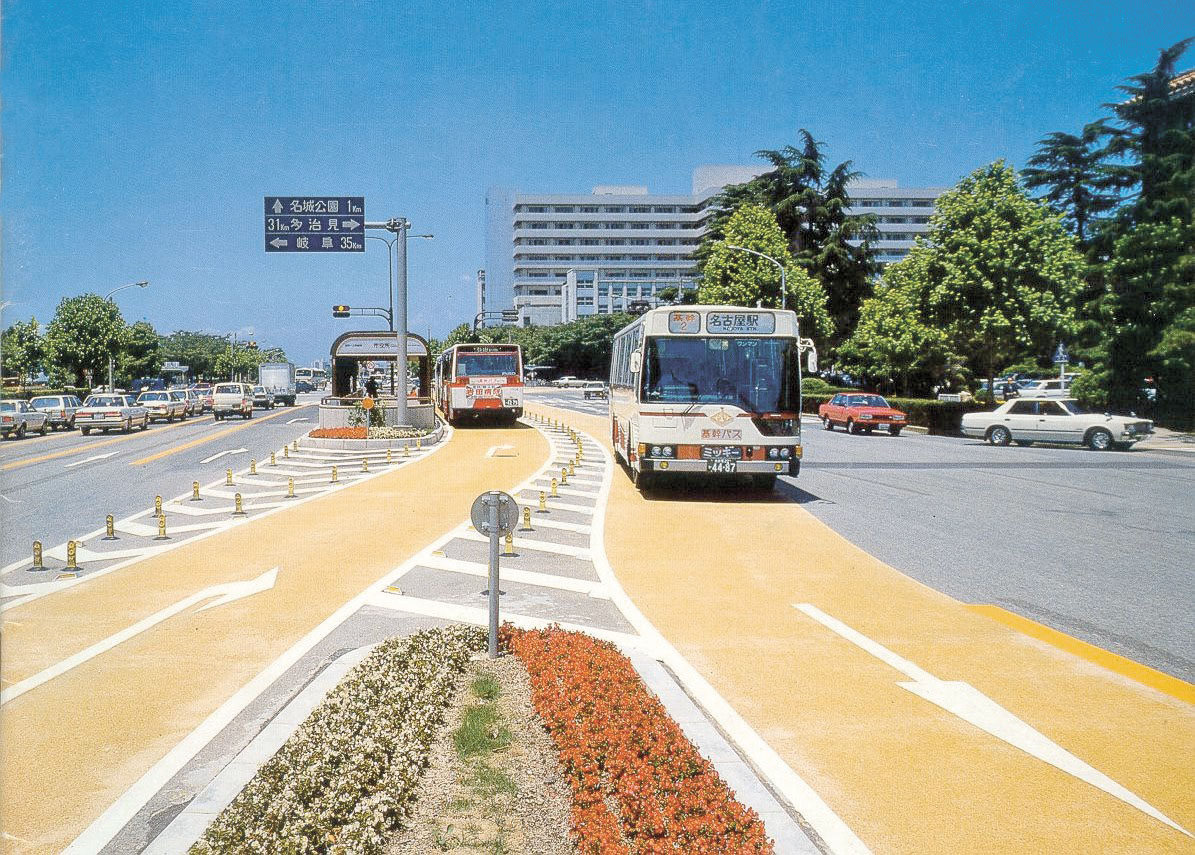

Colorization of busway lanes can be accomplished by at least three techniques. First, a road surface paint can be applied to the busway. The advantage of simply painting the lane is that coloration can be accomplished when just the existing street infrastructure is being converted to a busway. The disadvantage of paint-based techniques is the duration of the color and the long-term maintenance costs. A second option is to utilize a colored emulsion within the asphalt or a pigment within the concrete mix. In this case the coloration is a permanent part of the surface material. As the surface begins to wear down, the color is retained. Thirdly, a colored epoxy can be applied to the roadway surface and similar colored aggregate rolled into the epoxy surface. The epoxy surfacing will require regular maintenance (every two to five years), depending on the pavement loading, and has a relatively high application cost relative to the other options.
However, in general, the color finish of an emulsified and pigmented colored surface is less bright than a painted surface or epoxy. Thus, the aesthetic and marketing impact of an emulsified or pigmented surface will tend to be inferior to that of a painted or epoxy-coated surface.
Pigments can be used that produce a luminescent effect. A busway that is luminescent in the evening can be another way of attracting positive attention to the system. In Jakarta, the application of a red luminescent paint to the busway gives the system a majestic red-carpet appearance in the evenings.
The choice of color is highly specific to local preferences and local conditions. Further, a citywide color coding scheme should be considered as a mechanism to differentiate between various infrastructure purposes. For example, it might be useful to use a color for the busway that is different from the color utilized for the city’s bike lanes. In this way, each set of sustainable-transport infrastructure has its own unique visual identity. In general, darker colored shades should be selected over lighter colors. With time, tire marks will tend to stain busways with light colors, while such wear marks will be less pronounced with dark colors.
It is important that when assessing the colorization technique, be it paint, emulsion, epoxy, or pigment, the full life-cycle costs be assessed. Initial costs of paints and epoxy coating are relatively high when compared to pigmentation and asphalt emulsions. Pigmented concrete should last for the full forty-year lifespan of the slab, whereas the application on an asphalt surface will need to be replaced every time an asphalt surface is replaced, that is, every two to seven years depending on the pavement loading.

23.5.2Busway Delineation
While some busways are not at a different grade than mixed traffic, most are separated by a physical barrier. This barrier can range from a fully landscaped median to simple blocks, bollards, curbing, permanent traffic cones, walls, metal fencing, or other types of barrier devices. The design of the separator should be sufficient to physically prohibit mixed-traffic vehicles from entering the busway.

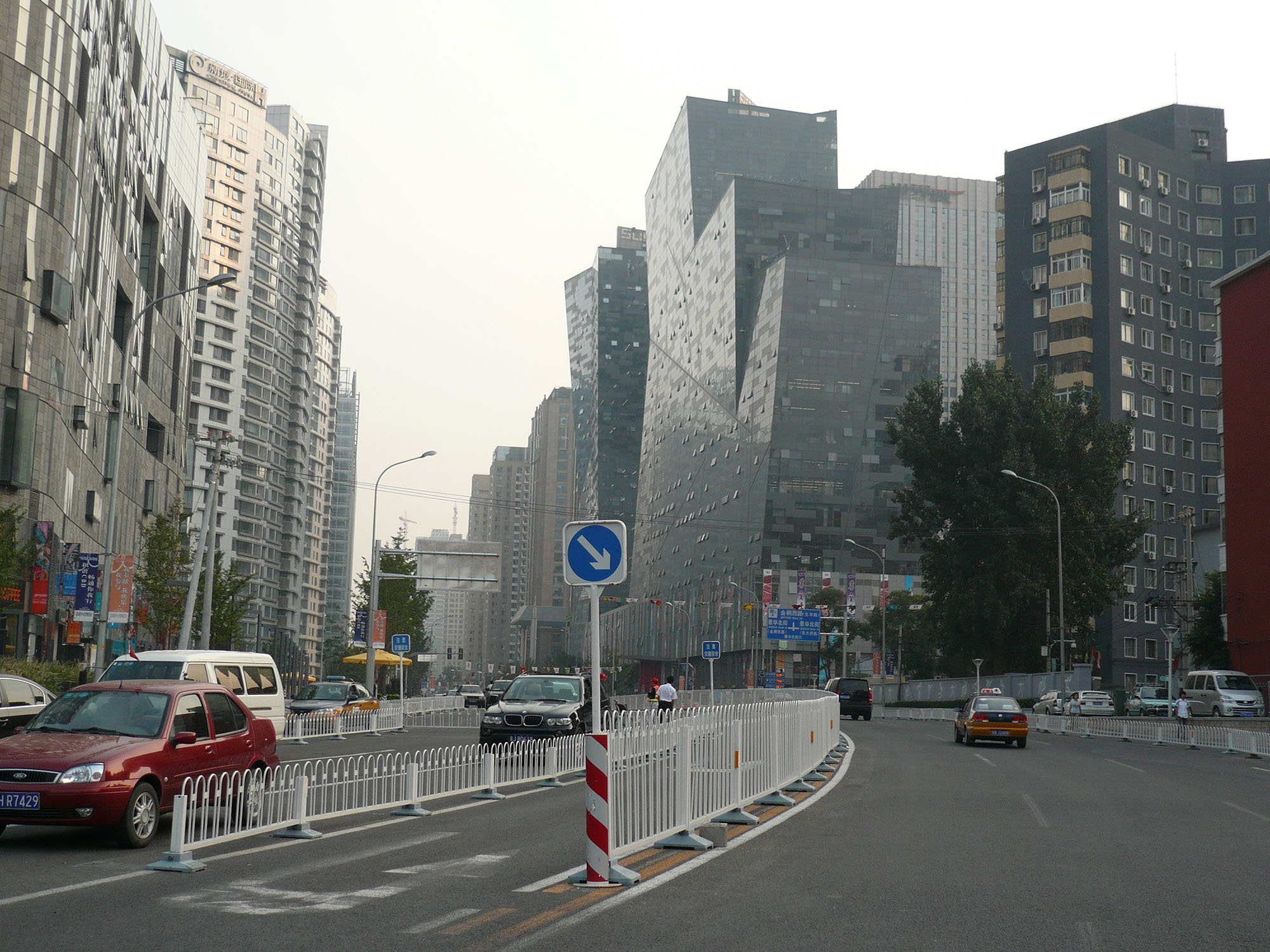
A wall or large landscaped median will provide the most complete protection for the busway, but will make it difficult for vehicles to escape the busway in case of an obstruction (Figure 23.18). Likewise, metal fencing, as utilized in Beijing, makes it impossible for the BRT vehicles to leave the corridor in case of emergency (Figure 23.19). However, the Beijing fencing does have an advantage as a movable barrier. If the system developers later widen the Beijing busway, then the fencing is relatively easy to relocate.
It may be useful to design the separator to permit buses to leave the busway in case of an obstruction. For example, if a bus breaks down on the busway, it can be useful to allow other buses to leave the lane to avoid being blocked. Thus, a curbing separator that is high enough to dissuade private vehicles from entering but low enough to allow buses to safely leave the busway can be appropriate (Figure 23.20). One option is to employ a curbing material that is rounded on the busway side but forms a sharp edge on the private vehicle side.

If it is likely that at times buses will need to cross the separator, the divider should be built strong enough so as not to break under the wheels of the bus, and low enough so as not to damage the bottom of the bus. In Quito, for example, the stone blocks used as separators are frequently damaged and dislocated, creating hazardous obstacles in the roadway and undermining the barrier function (Figure 23.21). The breakdown of the barrier can then subsequently lead to private vehicles infringing upon the busway, creating safety hazards to both the private vehicles and the BRT customers (Figure 23.22).
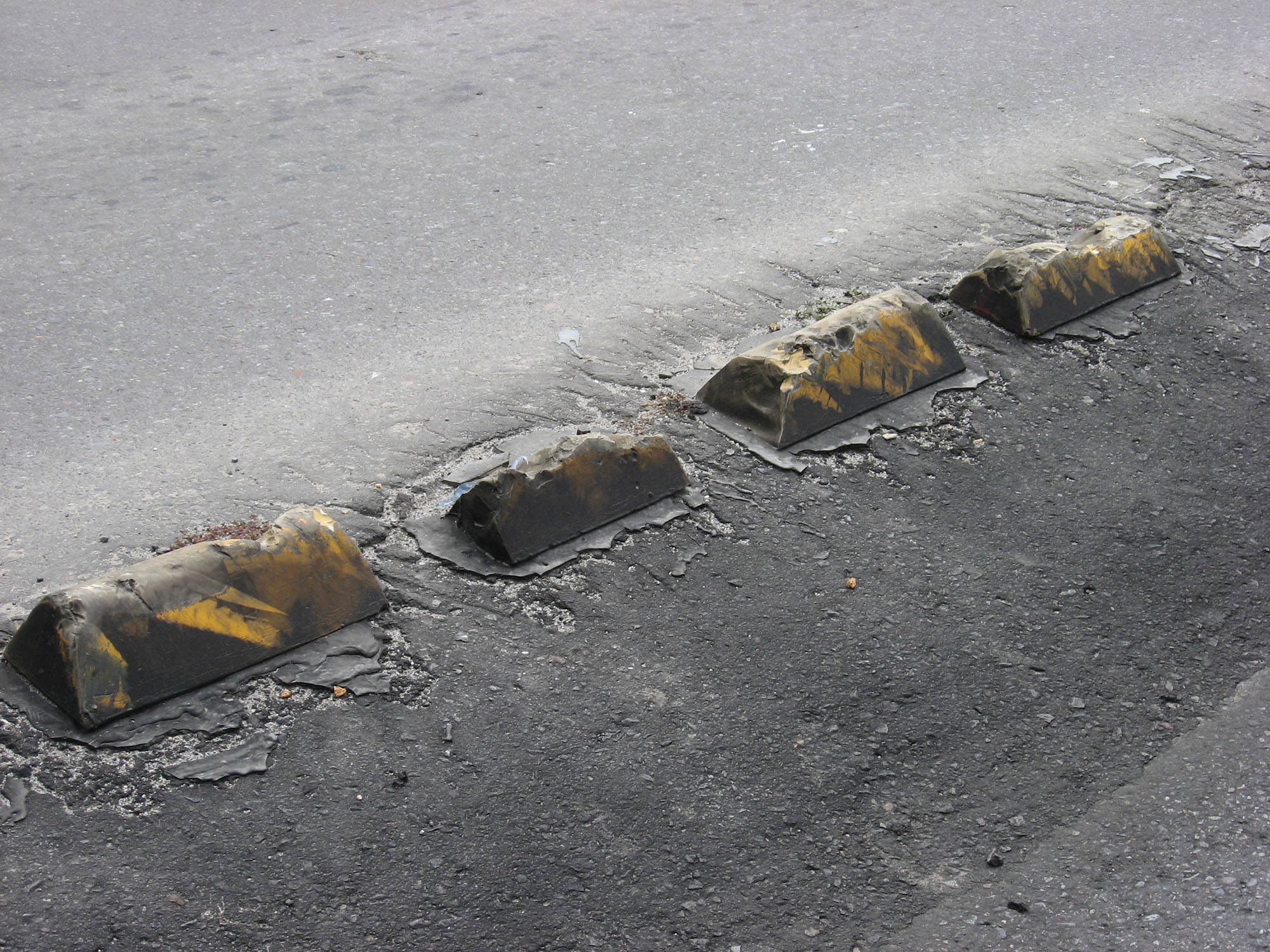
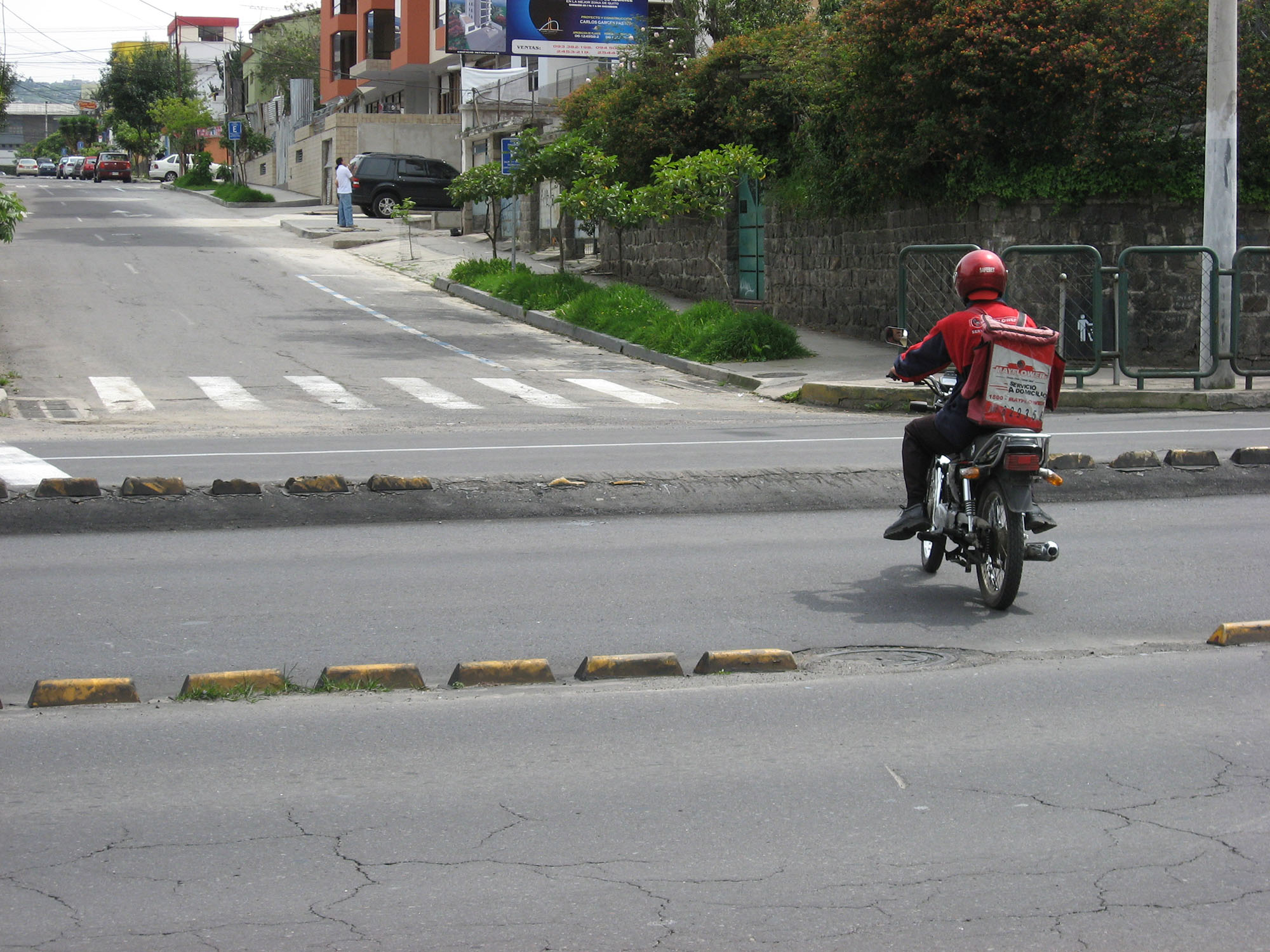
Pedestrian safety and aesthetics are other considerations. There are several advantages to using a meter-wide median to separate the busway from mixed traffic if the right-of-way allows. A meter-wide median allows the median to also serve as a refuge for pedestrians crossing the road. A larger median tends to also provide the most aesthetically pleasing and complete demarcation of the busway. Curitiba’s BRT system is separated by a low curb filled with decorative Portuguese stone, creating an aesthetically pleasing median that provides some pedestrian refuge (Figure 23.23). It was designed to facilitate crossing of the road anywhere along the corridor. In some places, motor-vehicle parking in Curitiba is also adjacent to this median divider rather than adjacent to the curb, so the parking lane becomes part of the barrier protecting the integrity of the busway.
Walls were originally used in the Santo Amaro/Nove de Julho corridor in São Paulo, which is not considered a BRT. The walls provided complete protection from encroachments. They were intended to make it impossible for pedestrians to cross the busway except at designated locations; however, the walls were not aesthetically pleasing and were impossible to escape if a vehicle broke down (Figure 23.24). They also created visibility problems for crossing pedestrians. The walls were eventually completely removed. This significantly improved the aesthetics of the corridor, but the busway now suffers from encroachments from motor vehicles.

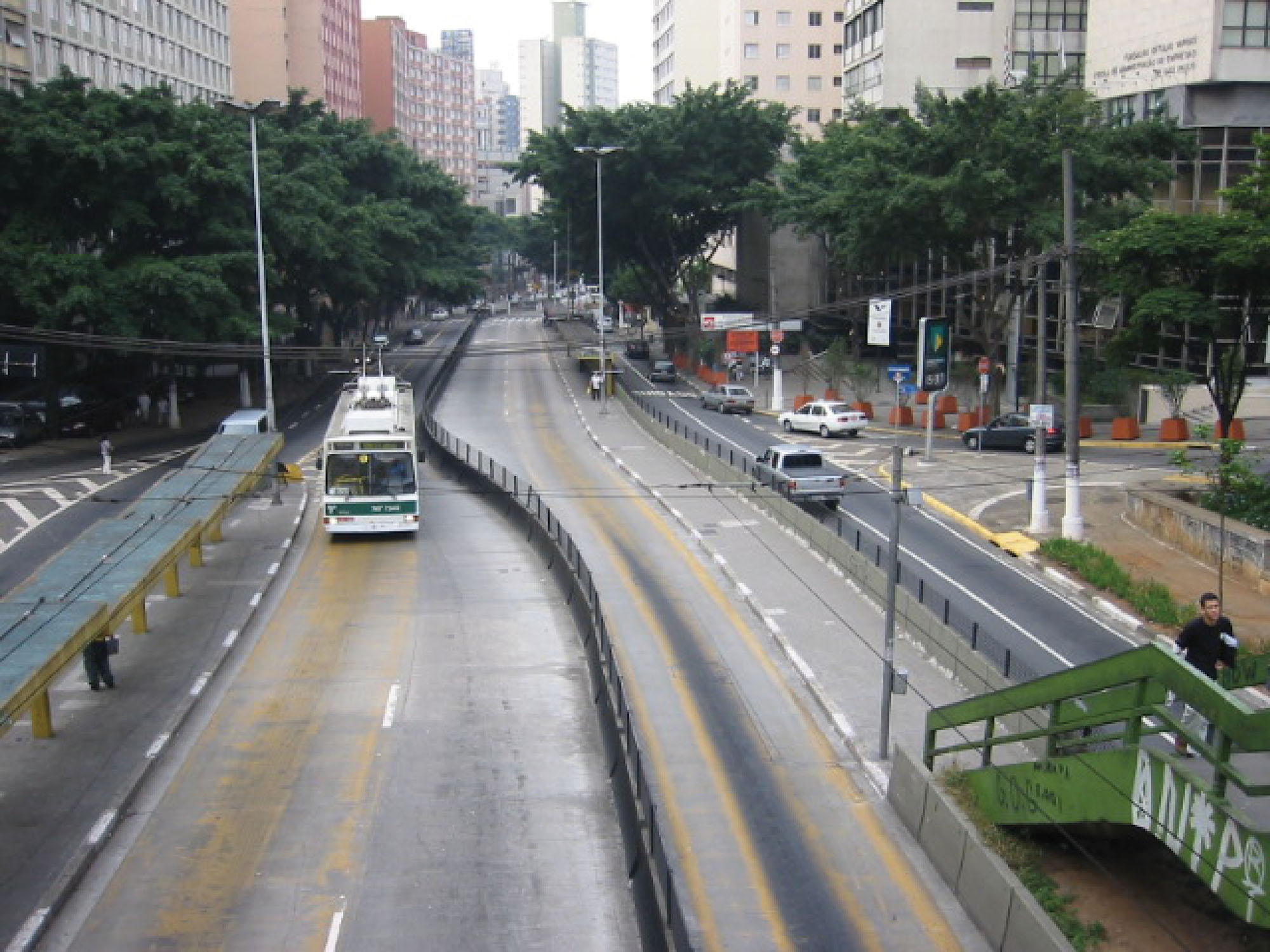
In pedestrian areas, the use of a separator medium will depend on the volume of BRT vehicles and pedestrians. In some instances, successful pedestrian malls have been created with no discernible separation between the busway and the pedestrian walkway. Instead, vehicle speeds are reduced to allow drivers to react to any pedestrians straying into the busway. However, in high-volume operations, partial or even full separation may be appropriate. Along the Bogotá Alameda Jiménez route (also known as the “Environmental Axis”) nicely designed bollards act to separate the busways from the pedestrian zone (Figure 23.25).

Busway Markings and Signage
Several mechanisms can be utilized to discourage private-vehicle use of the busway:
- Clear signage noting busway-use only (Figures 23.26 and 23.27);
- “Busway only” message imprinted on the busway surface (Figure 23.28);
- Distinctive coloration of the lanes;
- Median differentiation between the mixed traffic lanes and the busway.
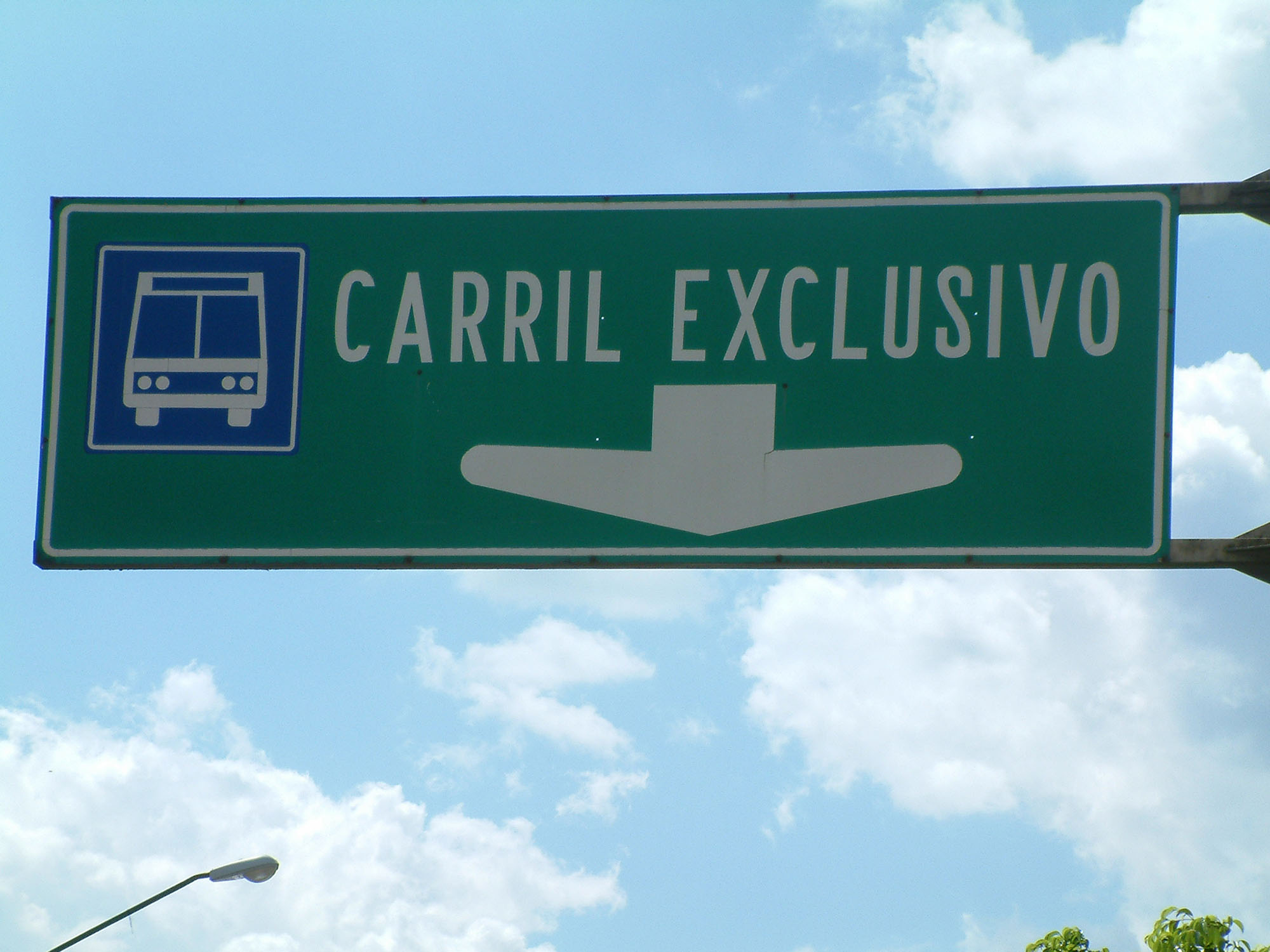

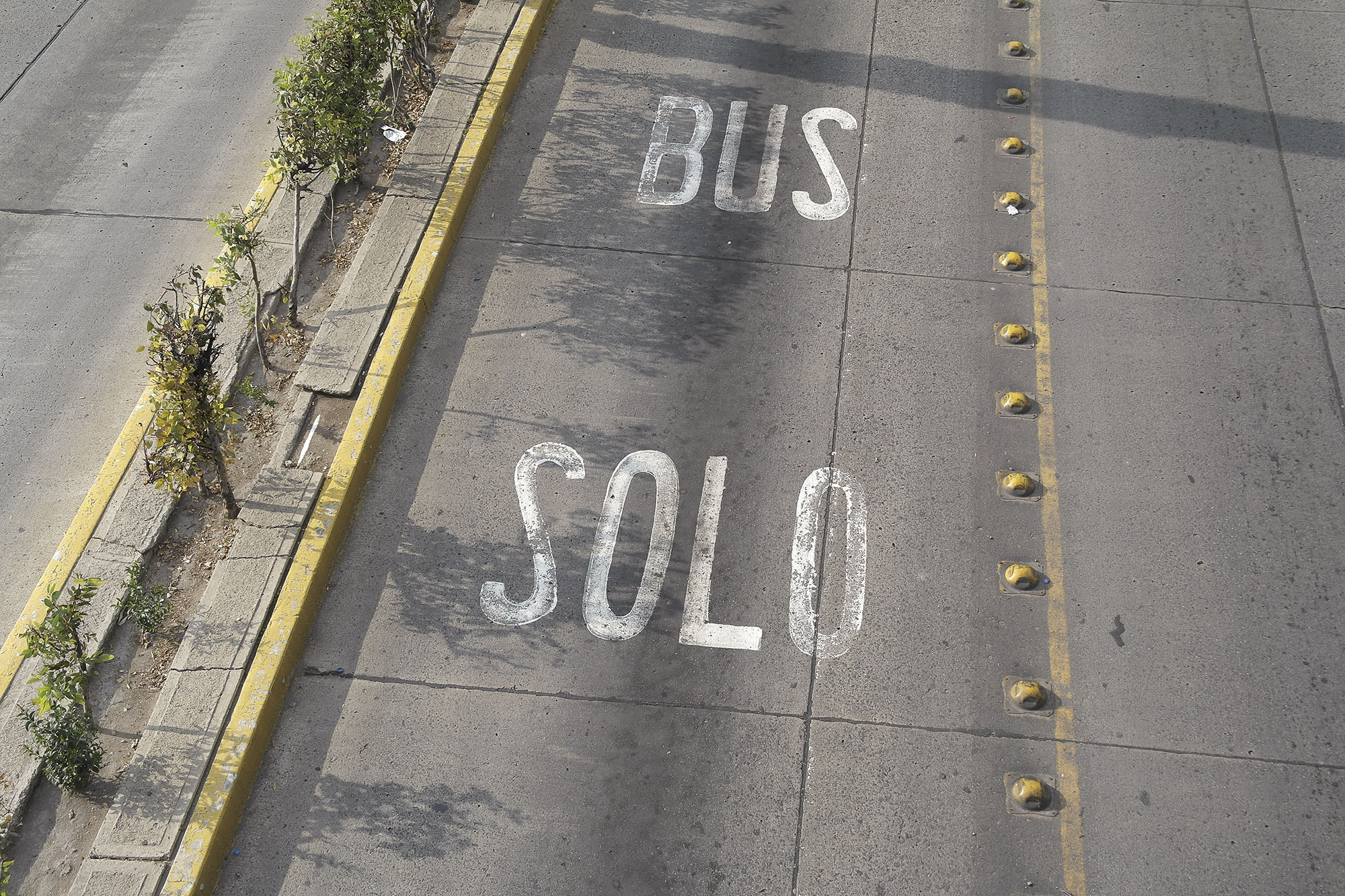
Without such measures, there may be instances of inadvertent use of the busway. However, these measures may not be sufficient to deter intentional violations of busway usage, and CCTV tracking and fining of offenders may have to be considered to protect the integrity of the dedicated bus lanes. Thus, cooperation with the traffic police in monitoring and enforcing the exclusivity of the busway is also essential.